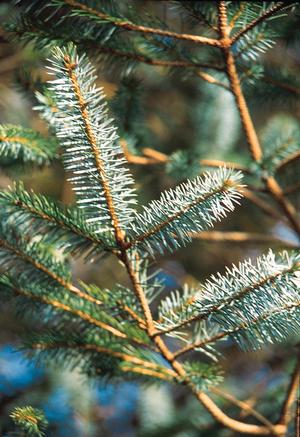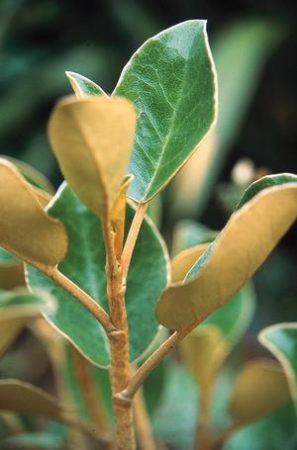Post category: easy-care garden
If plants are too cramped for space, it will mean more work pruning, or even the task of removing them. Although it seems obvious that plants should have enough space available to them, it is very common to see gardens where plants never had the prospect of having enough space for their proper development, as shown.

Match plant size to the space
The amount of space available to any plant has a major influence on its success. Each plant species has a normal height and spread. Plants are competitive for space and they tend to grow into each other in the attempt to reach the light. The fast growers will usually squeeze out the smaller plants, but plants of even vigour just end up spoiling each other – becoming one-sided, or very lanky, for example.
It is very important to find out the likely eventual size of any plant before planting. When a plant gets too big for the space available to it, it must be pruned drastically, or removed. The original planting and the subsequent pruning, or removal, all involve wasted time and effort as well as the destruction or complete waste of a good plant.
The problem of adequate space is most acute with the largest plants, namely trees, but it can occur with shrubs as well and even with non-woody flowers when over-rampant kinds are put in the wrong place.
However, it is important to point out that achieving the correct spacing for plants is not as easy as all that. Waiting for the plants to reach mature size, and fill their allotted space, takes too long and there will be ugly gaps in the meantime.
On the other hand, although close planting fills up the space more quickly, the plants soon become too crowded. Short-lived shrubs, perennial flowers and annual flowers – can be used to fill some of the space in the early years.
The necessity for pest control can be largely avoided. We carry the erroneous impression that plants need to be constantly treated with sprays of all kinds against pests and diseases. This is not the case. Although plants appear fairly helpless in defending themselves, they have a formidable range of defences against both pests and diseases. Healthy plants can ward off pest attack; it is nearly always plants growing in unsuitable conditions that succumb.
The most obvious defence against pests are the various kinds of thorns, spines, stinging and irritant hairs. These prevent animals from grazing the stems and leaves of plants. Few gardens have problems with grazing animals, though some have deer and rabbits.

Plants resist pests
Many plants have hairy or sticky stems and leaves. These aim to slow down the movement of greenflies and other small pests. Another very effective trick of plants against sap-sucking insects is the natural pressure of the plant sap.
Sucking insects like to use the pressure of the sap to feed themselves but when the plant is growing actively, the pressure can be too great for comfort. When the plant is short of moisture, the sap will be thick with sugars and released at a slower rate after the cells are punctured by the insect’s feeding tube.
Some plants have distasteful substances, even poisons, in the sap. Foxglove contains poisonous digitoxin; rhubarb has poisonous oxalic acid in the leaves. Yew trees contain poisons called taxines. The seeds of spurges contain powerful laxatives.
Oak leaves, indeed many plants, contain tannins that are very bitter and dissuade many animals that would like to eat them. Even so, oak is an important food source for hundreds of animal species that have adapted to the bitter taste.
Few true pests
Despite the effectiveness of physical and chemical defences against the majority of potential pests, most plants are attacked successfully by a variety of animals, especially insects. However, the pests of any one plant species are usually relatively few in number.
Some plants have no pests at all, some are attacked occasionally, a few are prone to more frequent attack. It is important to realise that while an insect, or other pest, might cause light damage to plants on occasion, it cannot be considered a significant pest.
In fact, the number of really significant pests of ornamental plants – that is, those which cause severe damage to plants – is very few. They include slugs and snails, and greenflies, occasionally rabbits are a serious problem in country gardens. Vegetables and fruit are prey to a few others like caterpillars and root flies that frequently cause problems, and can be considered serious pests.
Plants have another solution to the problem of pest attack; they simply outgrow it. Strong-growing healthy plants quickly outgrow the damage caused by pests. A few holes in leaves, even though the plant can look bad, is not significant to a healthy plant. It is constantly producing new leaves that replace any losses.
Predators
Remember, too, that plants are not on their own in this struggle because the pests themselves are prone to the attacks of parasites and predators. There is a long list of these: ladybirds, lacewings, hoverflies, shield bugs(as shown), groundbeetles, wasps, chalcid wasps, capsids, anthocorids, spiders, ichneumon wasps, frogs, hedgehogs and birds.

Plants resist pests
In fact, every insect or other animal seen in the garden that is not identifiably a pest is a beneficial predator or parasite. If we favour the beneficial insects and animals, the task of keeping plants pest-free is relatively easy. Finally, we can simply not grow plants that are persistently attacked by pests.
Not all plants are dogged by disease problems – a lot of hassle can be avoided by choosing resistant kinds and encouraging good plant health, and by simply not growing the disease-prone kinds. Although the plant defence mechanisms against pests are perhaps more obvious, the defences against fungi are no less effective, and useful to the easy-care gardener. Defences against fungi are mainly barriers of one kind or another.
Leaves of healthy plants are usually coated with wax that prevents the germination of disease spores. Within the sap, there are substances that reduce the growth of fungi, including the tannin mentioned above. The bark of trees and the thick skin of stems, like the waxy coating of leaves, act as a barrier against fungi.

Plants resist diseases
Plants that are attacked by fungi sometimes react by allowing a section of the leaf around the affected area to die. This causes a leaf spot and, occasionally, the plant can react to a disease by dropping all of its leaves, producing a new crop when the worst of the disease attack is over.
As is the case with pests, strong-growing healthy plants are better able to resist diseases. If plants are growing in suitable conditions of soil, site and climate, they will grow well and better resist disease. For example, during dry weather with growth reduced, plants are less able to withstand mildew, watering helps.
Equally, mildew-prone plants should not be grown in overly dry soil. On the other hand, if plants are growing very rapidly in over-rich soil, their tissues will become soft and watery; they are likely to suffer cankers, grey mould and leaf spot diseases.


